Comprehensive Business Plan for Hi Tea at Sylvia Park Shopping Centre
VerifiedAdded on 2023/04/21
|24
|3361
|190
Project
AI Summary
This business plan outlines the strategy for Hi Tea, a beverage company, focusing on the Sylvia Park Shopping Centre in Auckland, New Zealand. It includes an executive summary, table of contents, and detailed sections on the company's mission, vision, product portfolio (juices, smoothies, teas), and value proposition. The plan analyzes the industry, considering market size, trends, and environmental factors using PESTLE analysis. It also covers market analysis, including target market identification, need analysis, and market opportunities. The marketing strategy encompasses the product mix, pricing, placement, promotion, people, process, and physical evidence. SWOT analysis is provided, alongside operational details, human resources, and a six-year financial analysis, including a budget plan. The plan emphasizes the importance of local brands, natural drinks, and innovation within the competitive New Zealand beverage market, with a focus on profitability and customer satisfaction.
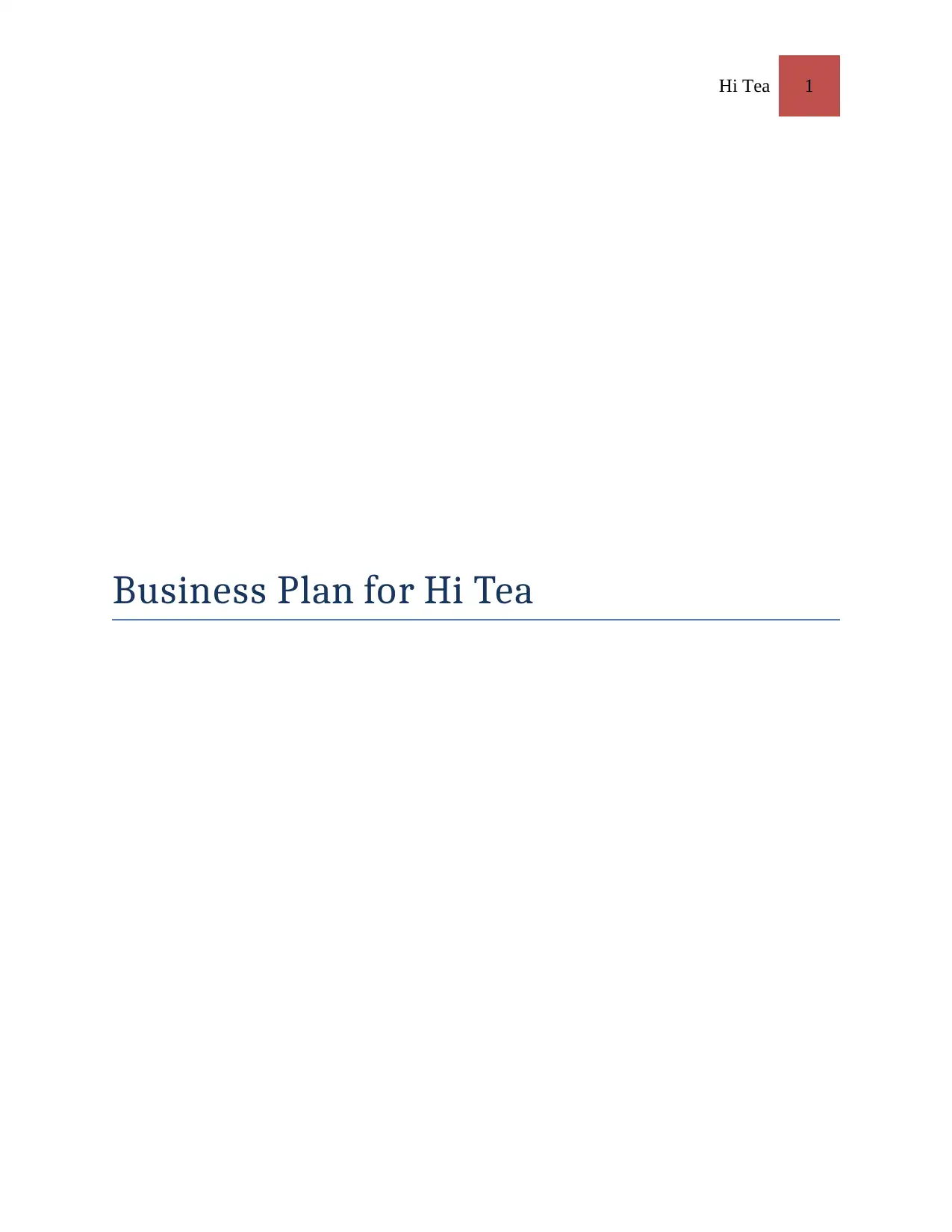
Hi Tea 1
Business Plan for Hi Tea
Business Plan for Hi Tea
Paraphrase This Document
Need a fresh take? Get an instant paraphrase of this document with our AI Paraphraser
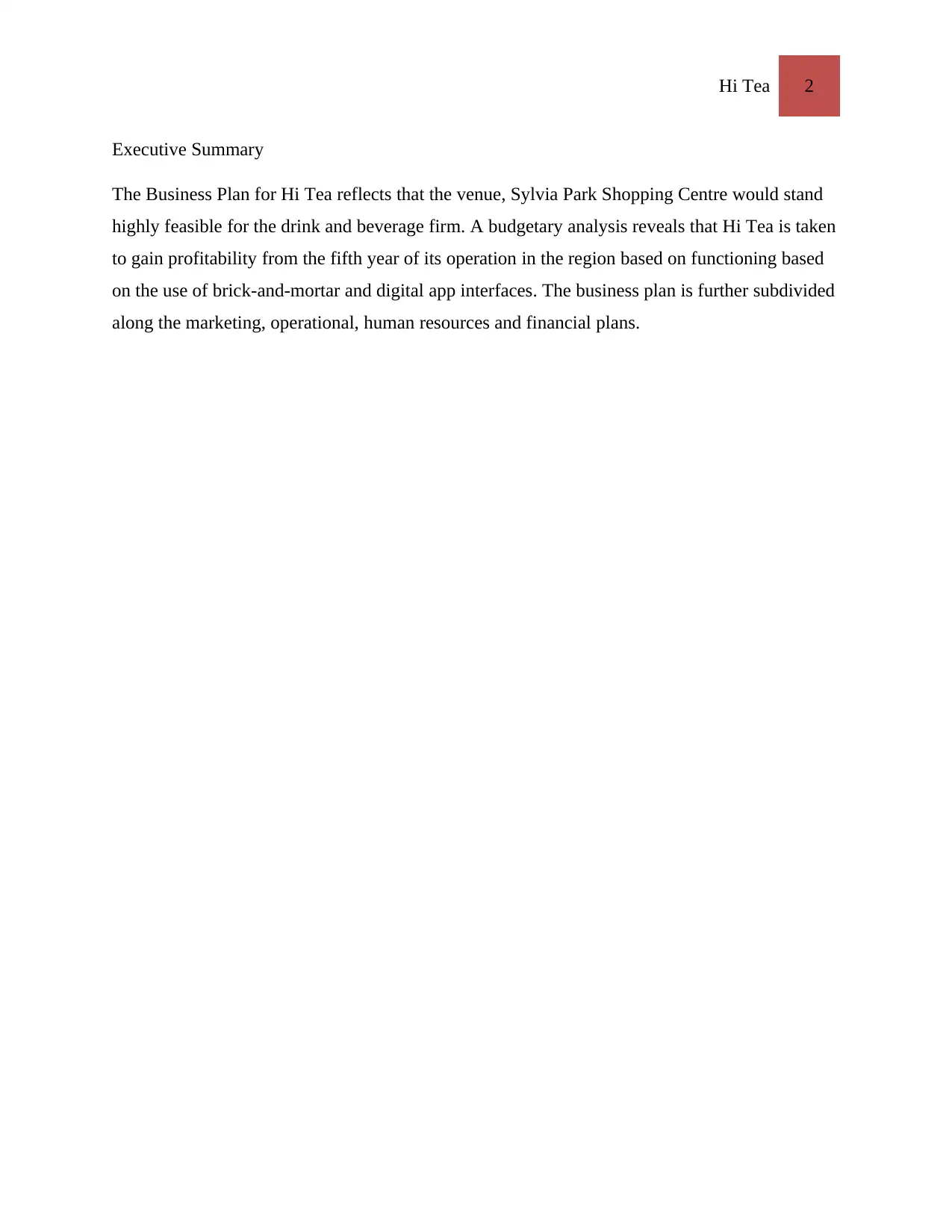
Hi Tea 2
Executive Summary
The Business Plan for Hi Tea reflects that the venue, Sylvia Park Shopping Centre would stand
highly feasible for the drink and beverage firm. A budgetary analysis reveals that Hi Tea is taken
to gain profitability from the fifth year of its operation in the region based on functioning based
on the use of brick-and-mortar and digital app interfaces. The business plan is further subdivided
along the marketing, operational, human resources and financial plans.
Executive Summary
The Business Plan for Hi Tea reflects that the venue, Sylvia Park Shopping Centre would stand
highly feasible for the drink and beverage firm. A budgetary analysis reveals that Hi Tea is taken
to gain profitability from the fifth year of its operation in the region based on functioning based
on the use of brick-and-mortar and digital app interfaces. The business plan is further subdivided
along the marketing, operational, human resources and financial plans.
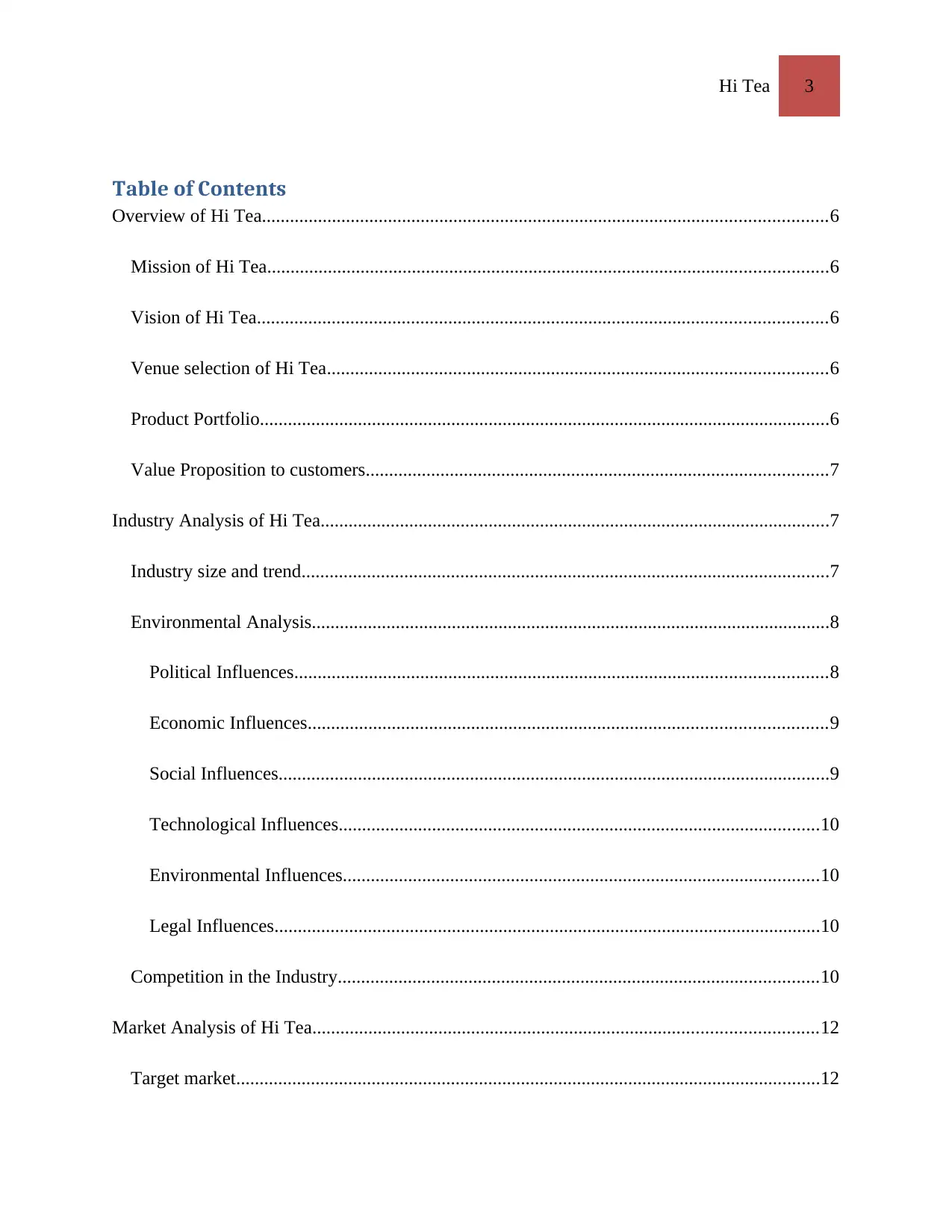
Hi Tea 3
Table of Contents
Overview of Hi Tea.........................................................................................................................6
Mission of Hi Tea........................................................................................................................6
Vision of Hi Tea..........................................................................................................................6
Venue selection of Hi Tea...........................................................................................................6
Product Portfolio..........................................................................................................................6
Value Proposition to customers...................................................................................................7
Industry Analysis of Hi Tea.............................................................................................................7
Industry size and trend.................................................................................................................7
Environmental Analysis...............................................................................................................8
Political Influences..................................................................................................................8
Economic Influences...............................................................................................................9
Social Influences......................................................................................................................9
Technological Influences.......................................................................................................10
Environmental Influences......................................................................................................10
Legal Influences.....................................................................................................................10
Competition in the Industry.......................................................................................................10
Market Analysis of Hi Tea............................................................................................................12
Target market.............................................................................................................................12
Table of Contents
Overview of Hi Tea.........................................................................................................................6
Mission of Hi Tea........................................................................................................................6
Vision of Hi Tea..........................................................................................................................6
Venue selection of Hi Tea...........................................................................................................6
Product Portfolio..........................................................................................................................6
Value Proposition to customers...................................................................................................7
Industry Analysis of Hi Tea.............................................................................................................7
Industry size and trend.................................................................................................................7
Environmental Analysis...............................................................................................................8
Political Influences..................................................................................................................8
Economic Influences...............................................................................................................9
Social Influences......................................................................................................................9
Technological Influences.......................................................................................................10
Environmental Influences......................................................................................................10
Legal Influences.....................................................................................................................10
Competition in the Industry.......................................................................................................10
Market Analysis of Hi Tea............................................................................................................12
Target market.............................................................................................................................12
⊘ This is a preview!⊘
Do you want full access?
Subscribe today to unlock all pages.

Trusted by 1+ million students worldwide
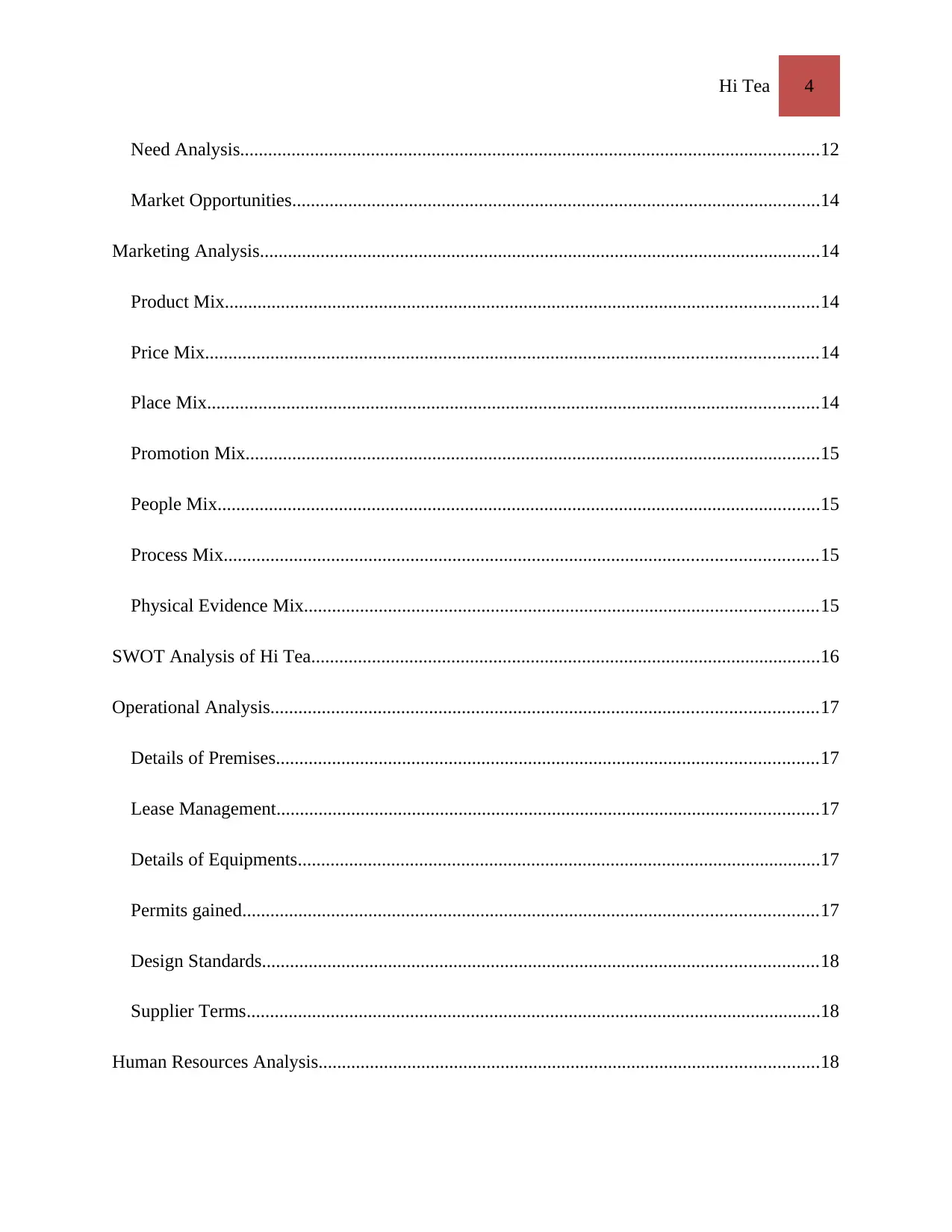
Hi Tea 4
Need Analysis............................................................................................................................12
Market Opportunities.................................................................................................................14
Marketing Analysis........................................................................................................................14
Product Mix...............................................................................................................................14
Price Mix...................................................................................................................................14
Place Mix...................................................................................................................................14
Promotion Mix...........................................................................................................................15
People Mix.................................................................................................................................15
Process Mix...............................................................................................................................15
Physical Evidence Mix..............................................................................................................15
SWOT Analysis of Hi Tea.............................................................................................................16
Operational Analysis.....................................................................................................................17
Details of Premises....................................................................................................................17
Lease Management....................................................................................................................17
Details of Equipments................................................................................................................17
Permits gained...........................................................................................................................17
Design Standards.......................................................................................................................18
Supplier Terms...........................................................................................................................18
Human Resources Analysis...........................................................................................................18
Need Analysis............................................................................................................................12
Market Opportunities.................................................................................................................14
Marketing Analysis........................................................................................................................14
Product Mix...............................................................................................................................14
Price Mix...................................................................................................................................14
Place Mix...................................................................................................................................14
Promotion Mix...........................................................................................................................15
People Mix.................................................................................................................................15
Process Mix...............................................................................................................................15
Physical Evidence Mix..............................................................................................................15
SWOT Analysis of Hi Tea.............................................................................................................16
Operational Analysis.....................................................................................................................17
Details of Premises....................................................................................................................17
Lease Management....................................................................................................................17
Details of Equipments................................................................................................................17
Permits gained...........................................................................................................................17
Design Standards.......................................................................................................................18
Supplier Terms...........................................................................................................................18
Human Resources Analysis...........................................................................................................18
Paraphrase This Document
Need a fresh take? Get an instant paraphrase of this document with our AI Paraphraser
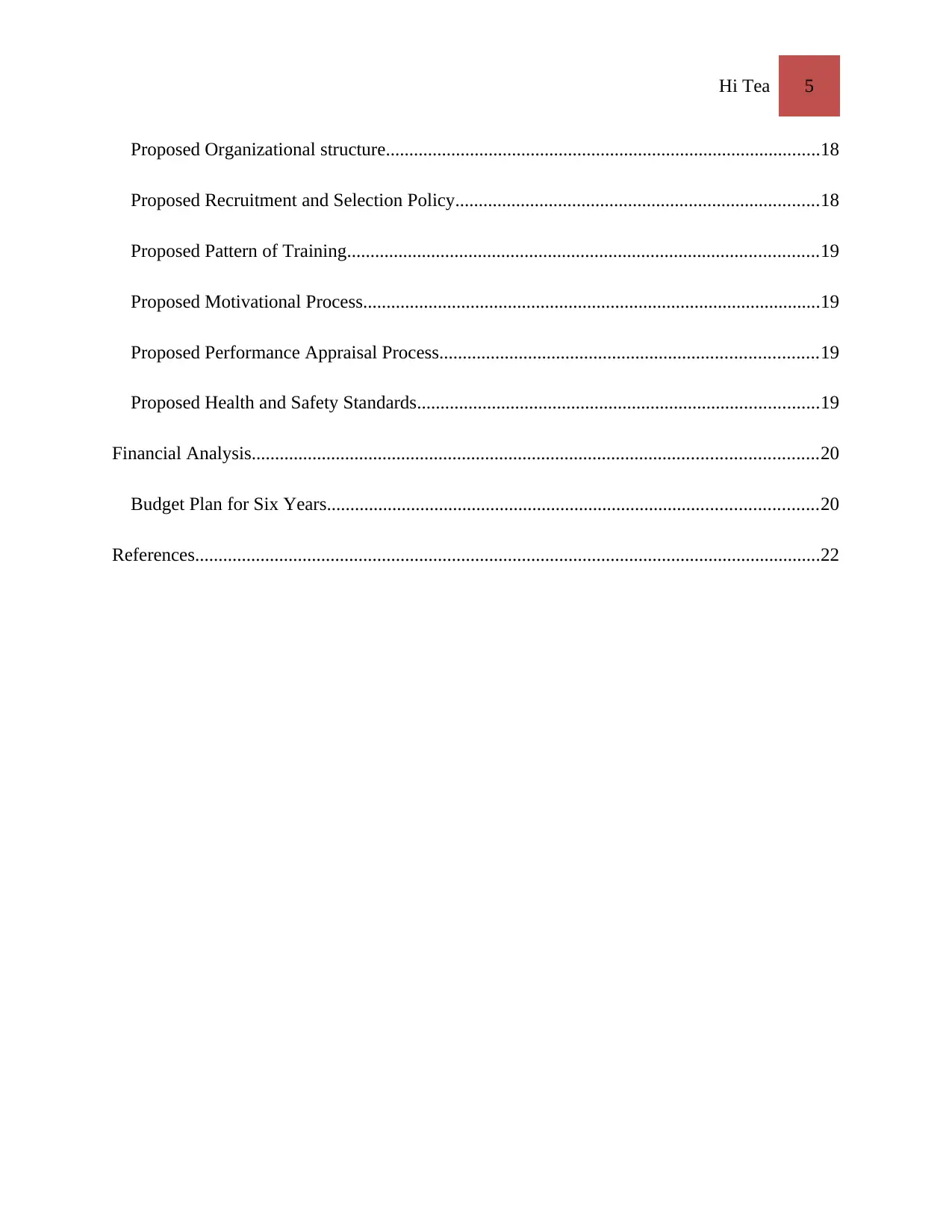
Hi Tea 5
Proposed Organizational structure.............................................................................................18
Proposed Recruitment and Selection Policy..............................................................................18
Proposed Pattern of Training.....................................................................................................19
Proposed Motivational Process..................................................................................................19
Proposed Performance Appraisal Process.................................................................................19
Proposed Health and Safety Standards......................................................................................19
Financial Analysis.........................................................................................................................20
Budget Plan for Six Years.........................................................................................................20
References......................................................................................................................................22
Proposed Organizational structure.............................................................................................18
Proposed Recruitment and Selection Policy..............................................................................18
Proposed Pattern of Training.....................................................................................................19
Proposed Motivational Process..................................................................................................19
Proposed Performance Appraisal Process.................................................................................19
Proposed Health and Safety Standards......................................................................................19
Financial Analysis.........................................................................................................................20
Budget Plan for Six Years.........................................................................................................20
References......................................................................................................................................22
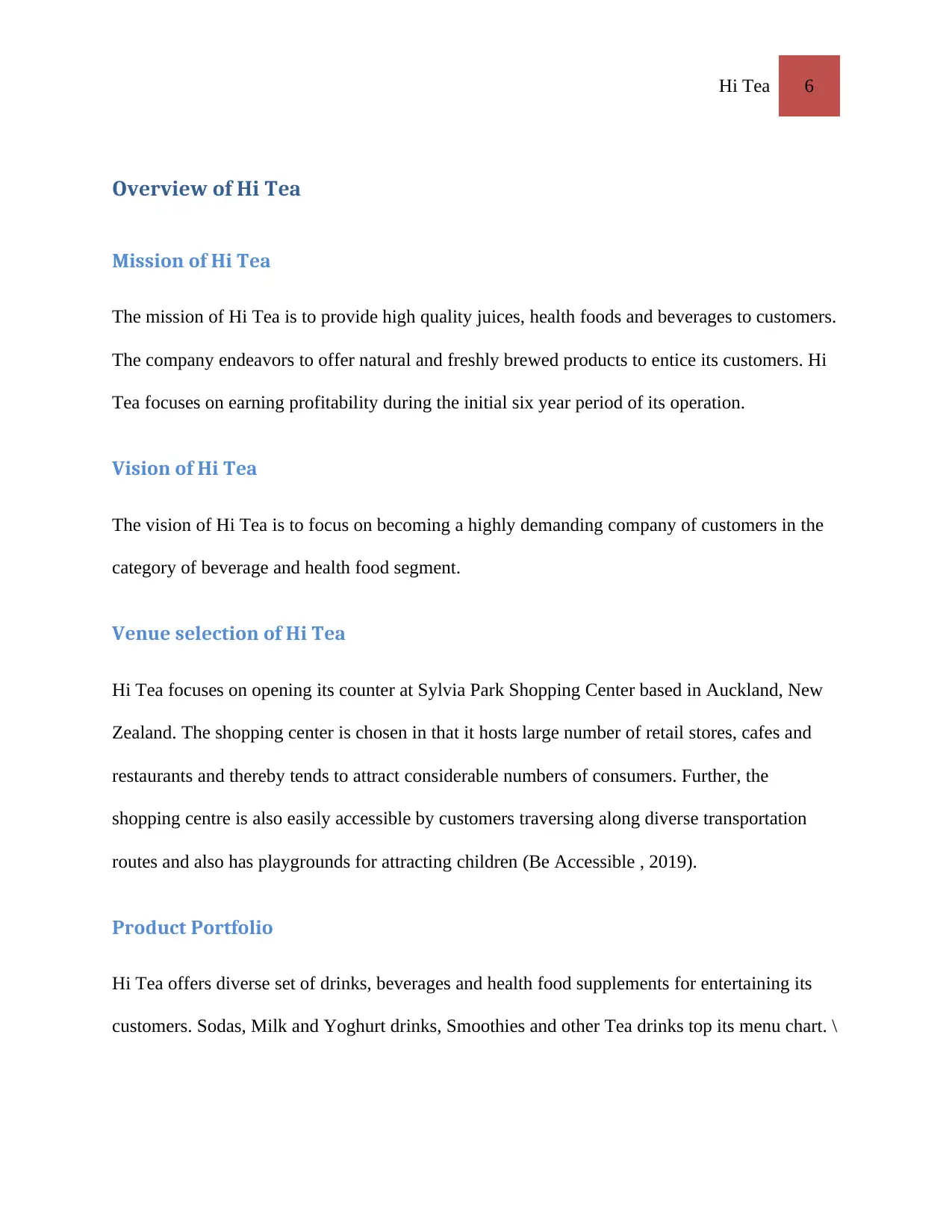
Hi Tea 6
Overview of Hi Tea
Mission of Hi Tea
The mission of Hi Tea is to provide high quality juices, health foods and beverages to customers.
The company endeavors to offer natural and freshly brewed products to entice its customers. Hi
Tea focuses on earning profitability during the initial six year period of its operation.
Vision of Hi Tea
The vision of Hi Tea is to focus on becoming a highly demanding company of customers in the
category of beverage and health food segment.
Venue selection of Hi Tea
Hi Tea focuses on opening its counter at Sylvia Park Shopping Center based in Auckland, New
Zealand. The shopping center is chosen in that it hosts large number of retail stores, cafes and
restaurants and thereby tends to attract considerable numbers of consumers. Further, the
shopping centre is also easily accessible by customers traversing along diverse transportation
routes and also has playgrounds for attracting children (Be Accessible , 2019).
Product Portfolio
Hi Tea offers diverse set of drinks, beverages and health food supplements for entertaining its
customers. Sodas, Milk and Yoghurt drinks, Smoothies and other Tea drinks top its menu chart. \
Overview of Hi Tea
Mission of Hi Tea
The mission of Hi Tea is to provide high quality juices, health foods and beverages to customers.
The company endeavors to offer natural and freshly brewed products to entice its customers. Hi
Tea focuses on earning profitability during the initial six year period of its operation.
Vision of Hi Tea
The vision of Hi Tea is to focus on becoming a highly demanding company of customers in the
category of beverage and health food segment.
Venue selection of Hi Tea
Hi Tea focuses on opening its counter at Sylvia Park Shopping Center based in Auckland, New
Zealand. The shopping center is chosen in that it hosts large number of retail stores, cafes and
restaurants and thereby tends to attract considerable numbers of consumers. Further, the
shopping centre is also easily accessible by customers traversing along diverse transportation
routes and also has playgrounds for attracting children (Be Accessible , 2019).
Product Portfolio
Hi Tea offers diverse set of drinks, beverages and health food supplements for entertaining its
customers. Sodas, Milk and Yoghurt drinks, Smoothies and other Tea drinks top its menu chart. \
⊘ This is a preview!⊘
Do you want full access?
Subscribe today to unlock all pages.

Trusted by 1+ million students worldwide
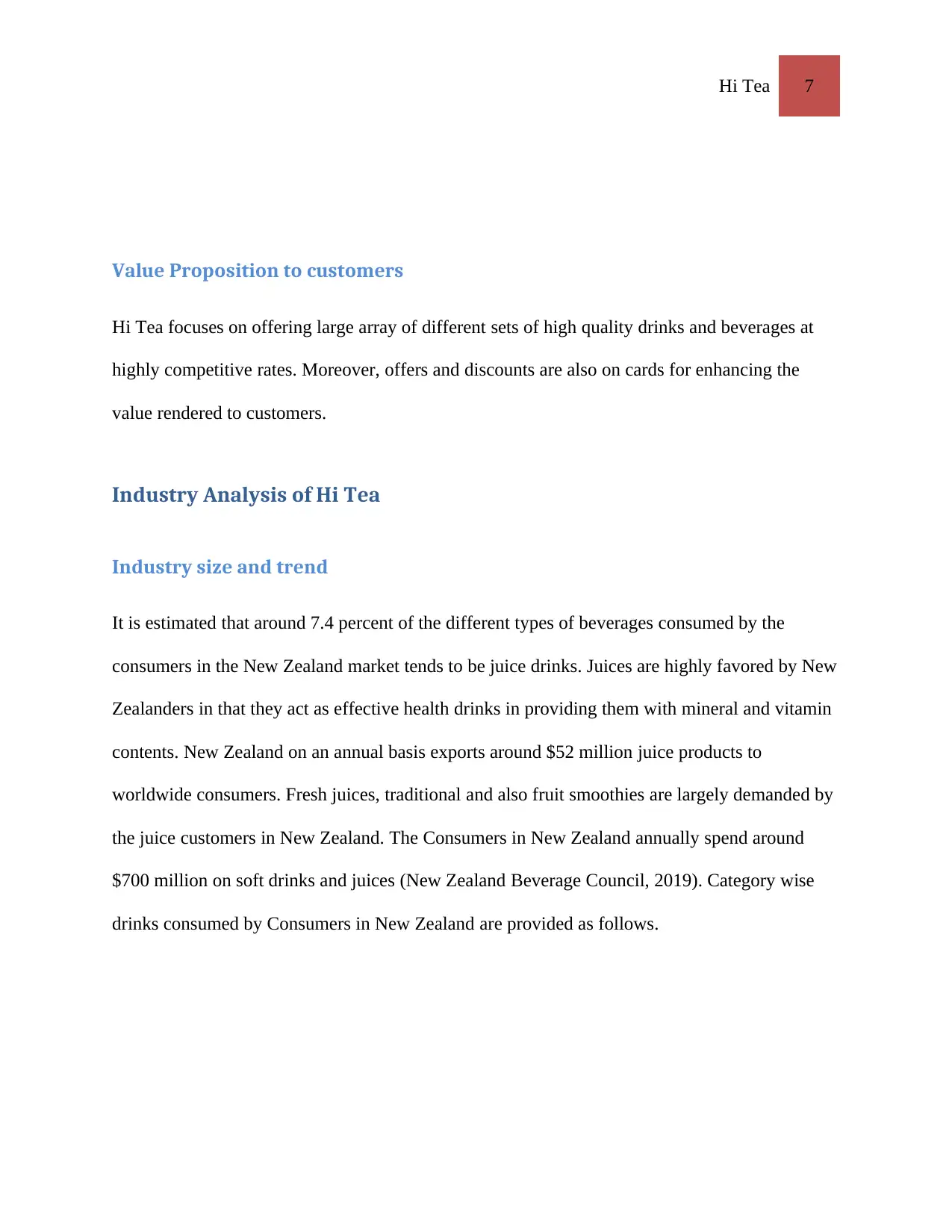
Hi Tea 7
Value Proposition to customers
Hi Tea focuses on offering large array of different sets of high quality drinks and beverages at
highly competitive rates. Moreover, offers and discounts are also on cards for enhancing the
value rendered to customers.
Industry Analysis of Hi Tea
Industry size and trend
It is estimated that around 7.4 percent of the different types of beverages consumed by the
consumers in the New Zealand market tends to be juice drinks. Juices are highly favored by New
Zealanders in that they act as effective health drinks in providing them with mineral and vitamin
contents. New Zealand on an annual basis exports around $52 million juice products to
worldwide consumers. Fresh juices, traditional and also fruit smoothies are largely demanded by
the juice customers in New Zealand. The Consumers in New Zealand annually spend around
$700 million on soft drinks and juices (New Zealand Beverage Council, 2019). Category wise
drinks consumed by Consumers in New Zealand are provided as follows.
Value Proposition to customers
Hi Tea focuses on offering large array of different sets of high quality drinks and beverages at
highly competitive rates. Moreover, offers and discounts are also on cards for enhancing the
value rendered to customers.
Industry Analysis of Hi Tea
Industry size and trend
It is estimated that around 7.4 percent of the different types of beverages consumed by the
consumers in the New Zealand market tends to be juice drinks. Juices are highly favored by New
Zealanders in that they act as effective health drinks in providing them with mineral and vitamin
contents. New Zealand on an annual basis exports around $52 million juice products to
worldwide consumers. Fresh juices, traditional and also fruit smoothies are largely demanded by
the juice customers in New Zealand. The Consumers in New Zealand annually spend around
$700 million on soft drinks and juices (New Zealand Beverage Council, 2019). Category wise
drinks consumed by Consumers in New Zealand are provided as follows.
Paraphrase This Document
Need a fresh take? Get an instant paraphrase of this document with our AI Paraphraser
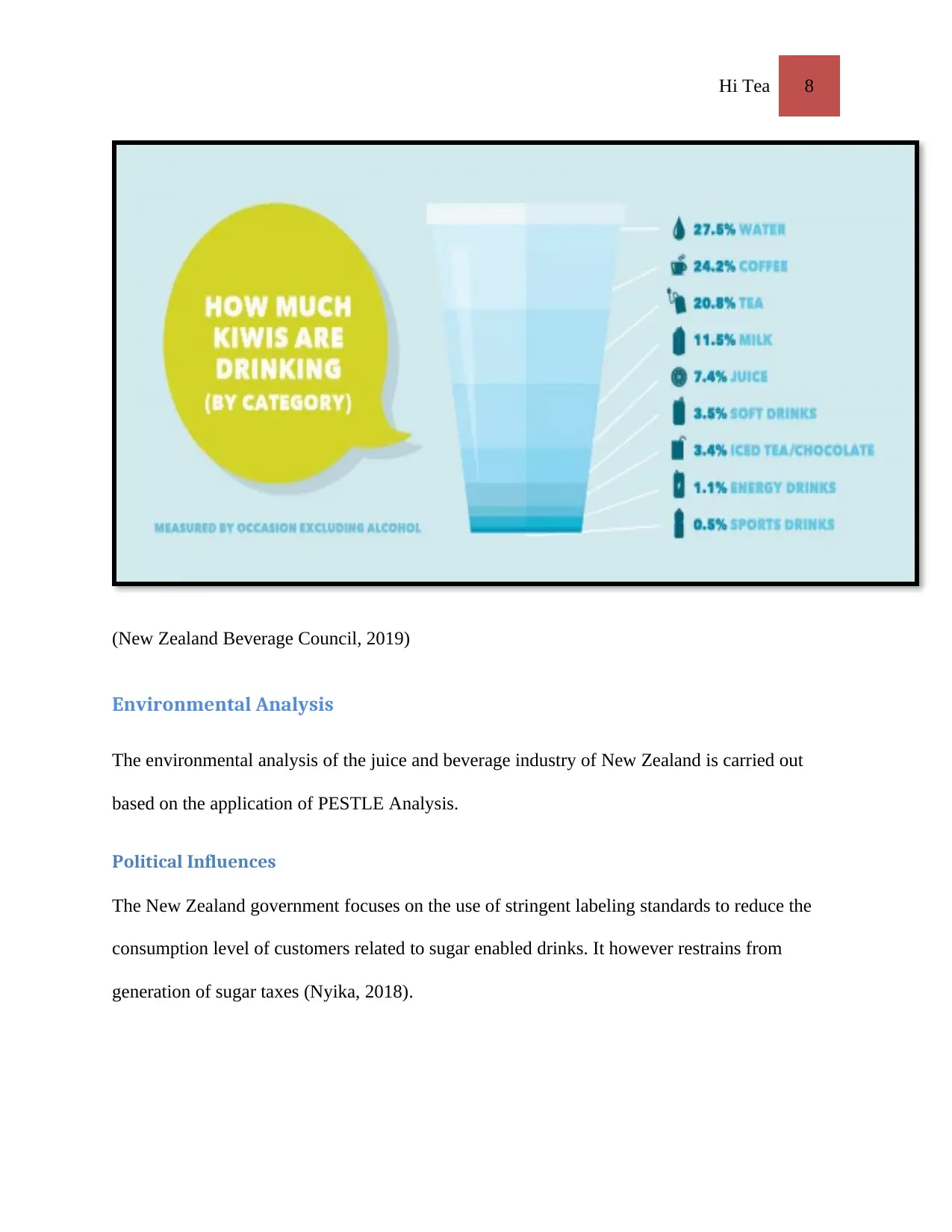
Hi Tea 8
(New Zealand Beverage Council, 2019)
Environmental Analysis
The environmental analysis of the juice and beverage industry of New Zealand is carried out
based on the application of PESTLE Analysis.
Political Influences
The New Zealand government focuses on the use of stringent labeling standards to reduce the
consumption level of customers related to sugar enabled drinks. It however restrains from
generation of sugar taxes (Nyika, 2018).
(New Zealand Beverage Council, 2019)
Environmental Analysis
The environmental analysis of the juice and beverage industry of New Zealand is carried out
based on the application of PESTLE Analysis.
Political Influences
The New Zealand government focuses on the use of stringent labeling standards to reduce the
consumption level of customers related to sugar enabled drinks. It however restrains from
generation of sugar taxes (Nyika, 2018).
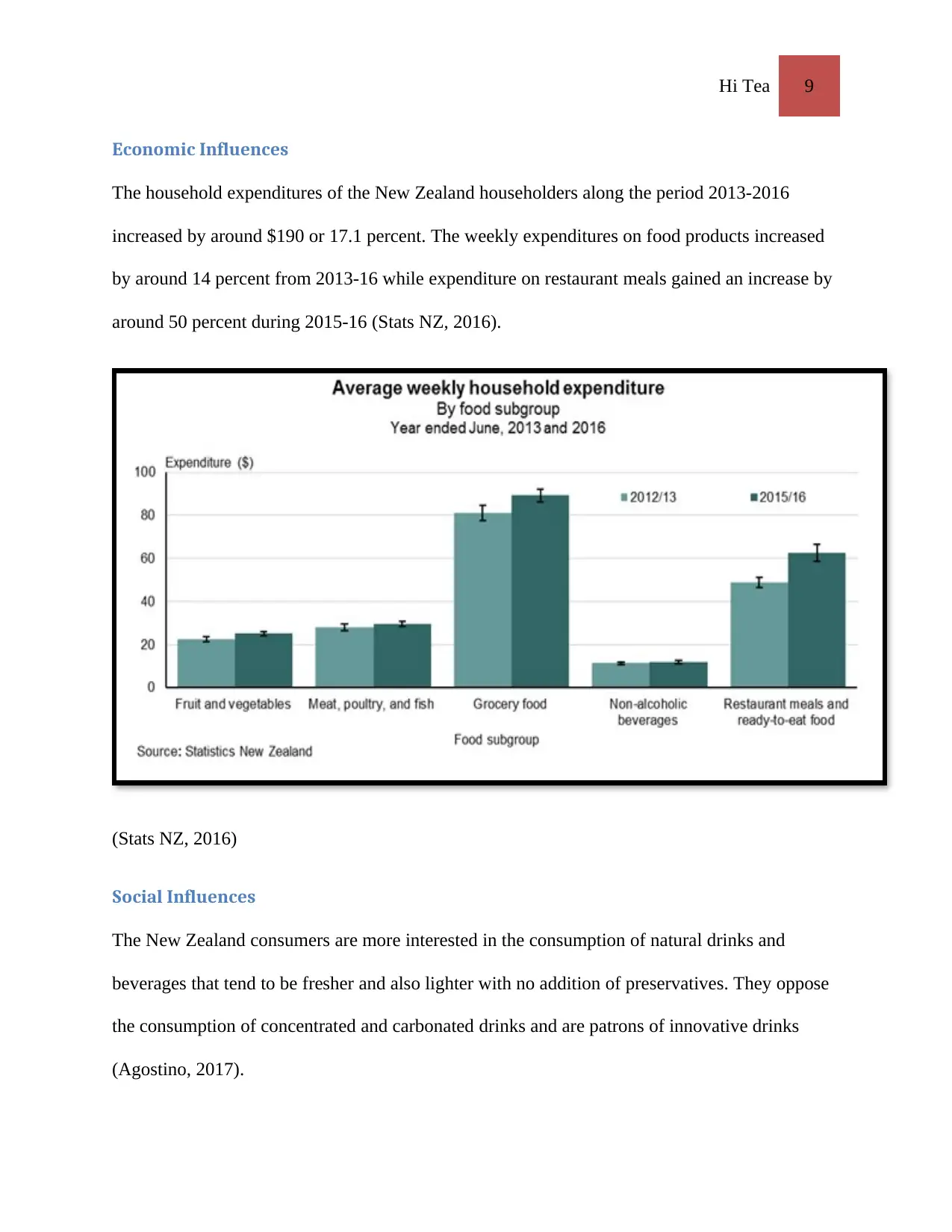
Hi Tea 9
Economic Influences
The household expenditures of the New Zealand householders along the period 2013-2016
increased by around $190 or 17.1 percent. The weekly expenditures on food products increased
by around 14 percent from 2013-16 while expenditure on restaurant meals gained an increase by
around 50 percent during 2015-16 (Stats NZ, 2016).
(Stats NZ, 2016)
Social Influences
The New Zealand consumers are more interested in the consumption of natural drinks and
beverages that tend to be fresher and also lighter with no addition of preservatives. They oppose
the consumption of concentrated and carbonated drinks and are patrons of innovative drinks
(Agostino, 2017).
Economic Influences
The household expenditures of the New Zealand householders along the period 2013-2016
increased by around $190 or 17.1 percent. The weekly expenditures on food products increased
by around 14 percent from 2013-16 while expenditure on restaurant meals gained an increase by
around 50 percent during 2015-16 (Stats NZ, 2016).
(Stats NZ, 2016)
Social Influences
The New Zealand consumers are more interested in the consumption of natural drinks and
beverages that tend to be fresher and also lighter with no addition of preservatives. They oppose
the consumption of concentrated and carbonated drinks and are patrons of innovative drinks
(Agostino, 2017).
⊘ This is a preview!⊘
Do you want full access?
Subscribe today to unlock all pages.

Trusted by 1+ million students worldwide
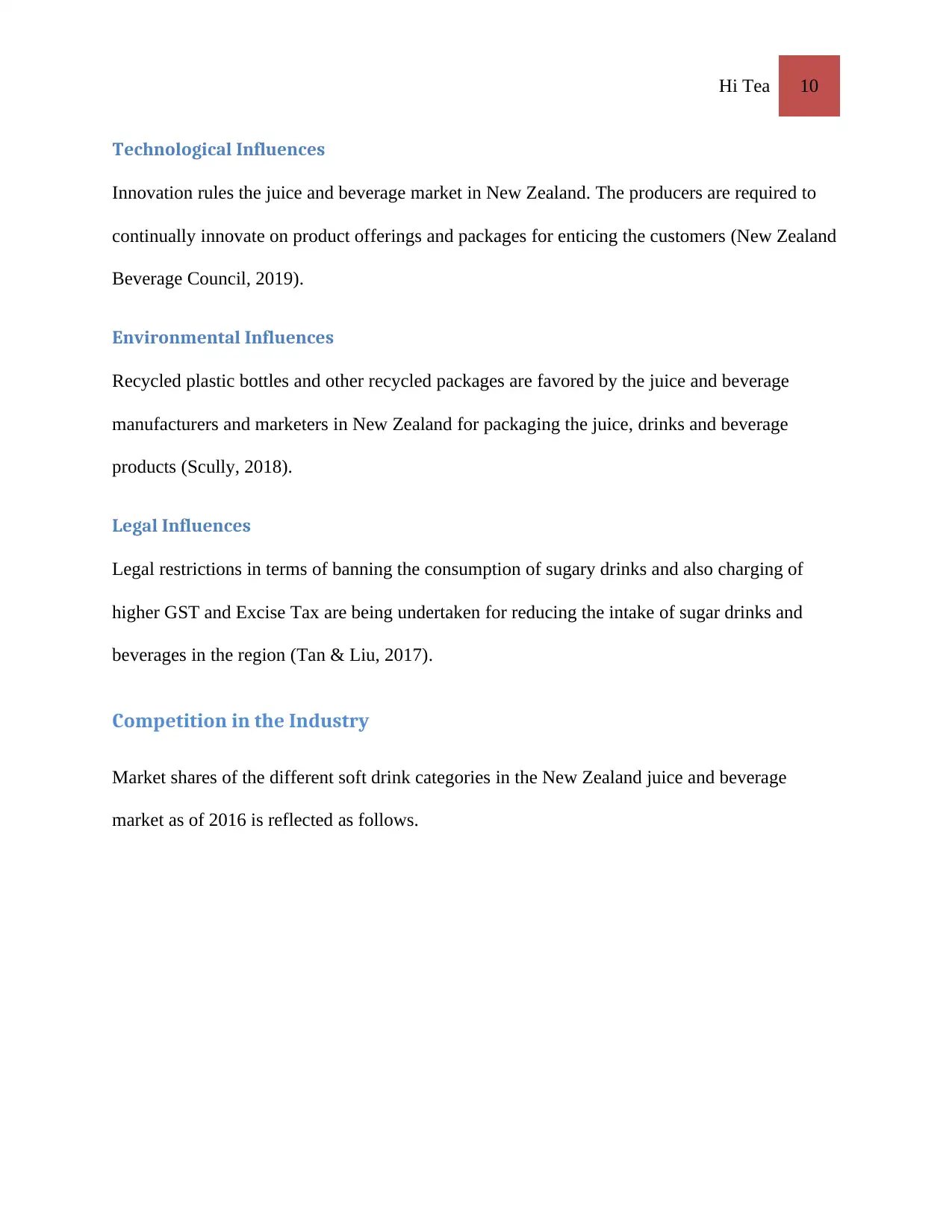
Hi Tea 10
Technological Influences
Innovation rules the juice and beverage market in New Zealand. The producers are required to
continually innovate on product offerings and packages for enticing the customers (New Zealand
Beverage Council, 2019).
Environmental Influences
Recycled plastic bottles and other recycled packages are favored by the juice and beverage
manufacturers and marketers in New Zealand for packaging the juice, drinks and beverage
products (Scully, 2018).
Legal Influences
Legal restrictions in terms of banning the consumption of sugary drinks and also charging of
higher GST and Excise Tax are being undertaken for reducing the intake of sugar drinks and
beverages in the region (Tan & Liu, 2017).
Competition in the Industry
Market shares of the different soft drink categories in the New Zealand juice and beverage
market as of 2016 is reflected as follows.
Technological Influences
Innovation rules the juice and beverage market in New Zealand. The producers are required to
continually innovate on product offerings and packages for enticing the customers (New Zealand
Beverage Council, 2019).
Environmental Influences
Recycled plastic bottles and other recycled packages are favored by the juice and beverage
manufacturers and marketers in New Zealand for packaging the juice, drinks and beverage
products (Scully, 2018).
Legal Influences
Legal restrictions in terms of banning the consumption of sugary drinks and also charging of
higher GST and Excise Tax are being undertaken for reducing the intake of sugar drinks and
beverages in the region (Tan & Liu, 2017).
Competition in the Industry
Market shares of the different soft drink categories in the New Zealand juice and beverage
market as of 2016 is reflected as follows.
Paraphrase This Document
Need a fresh take? Get an instant paraphrase of this document with our AI Paraphraser
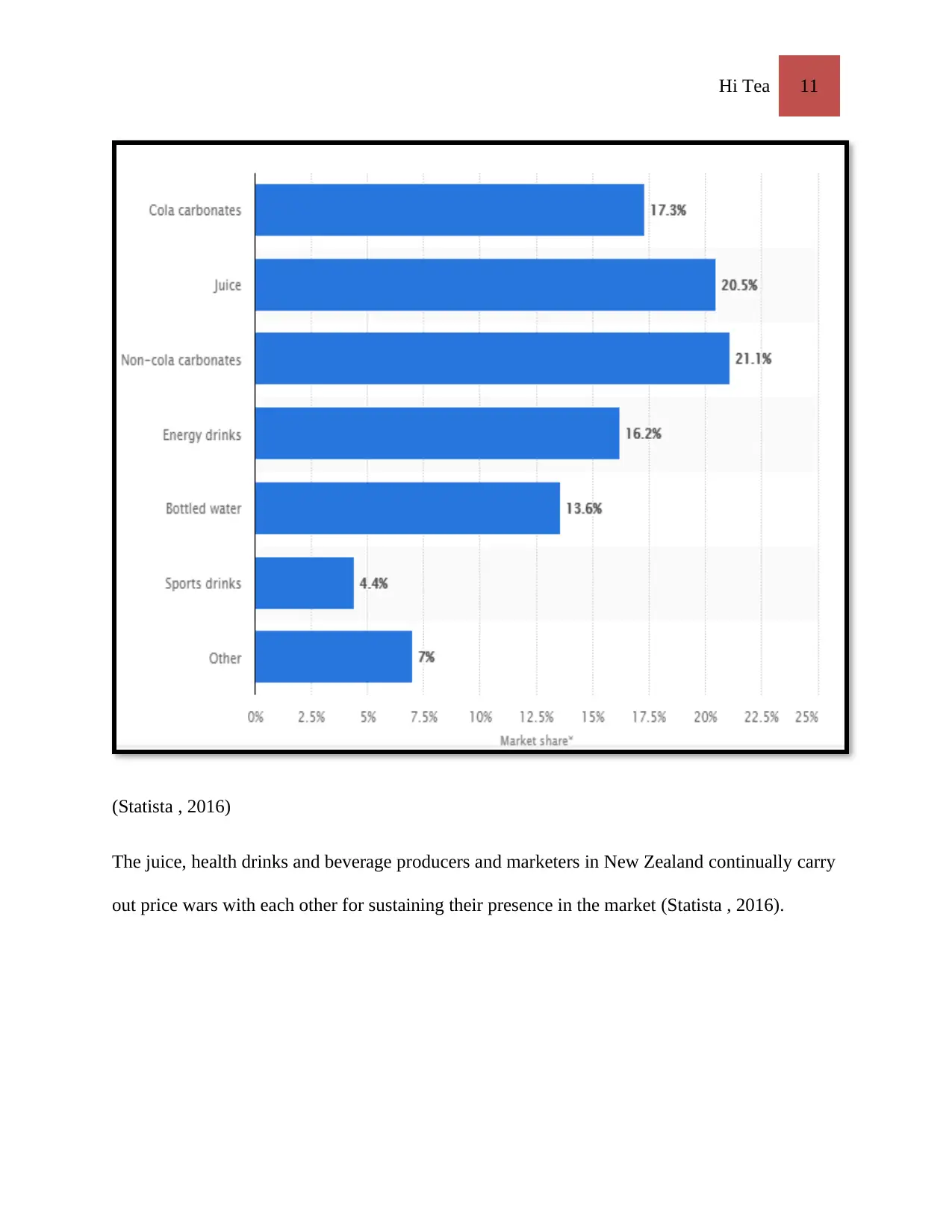
Hi Tea 11
(Statista , 2016)
The juice, health drinks and beverage producers and marketers in New Zealand continually carry
out price wars with each other for sustaining their presence in the market (Statista , 2016).
(Statista , 2016)
The juice, health drinks and beverage producers and marketers in New Zealand continually carry
out price wars with each other for sustaining their presence in the market (Statista , 2016).
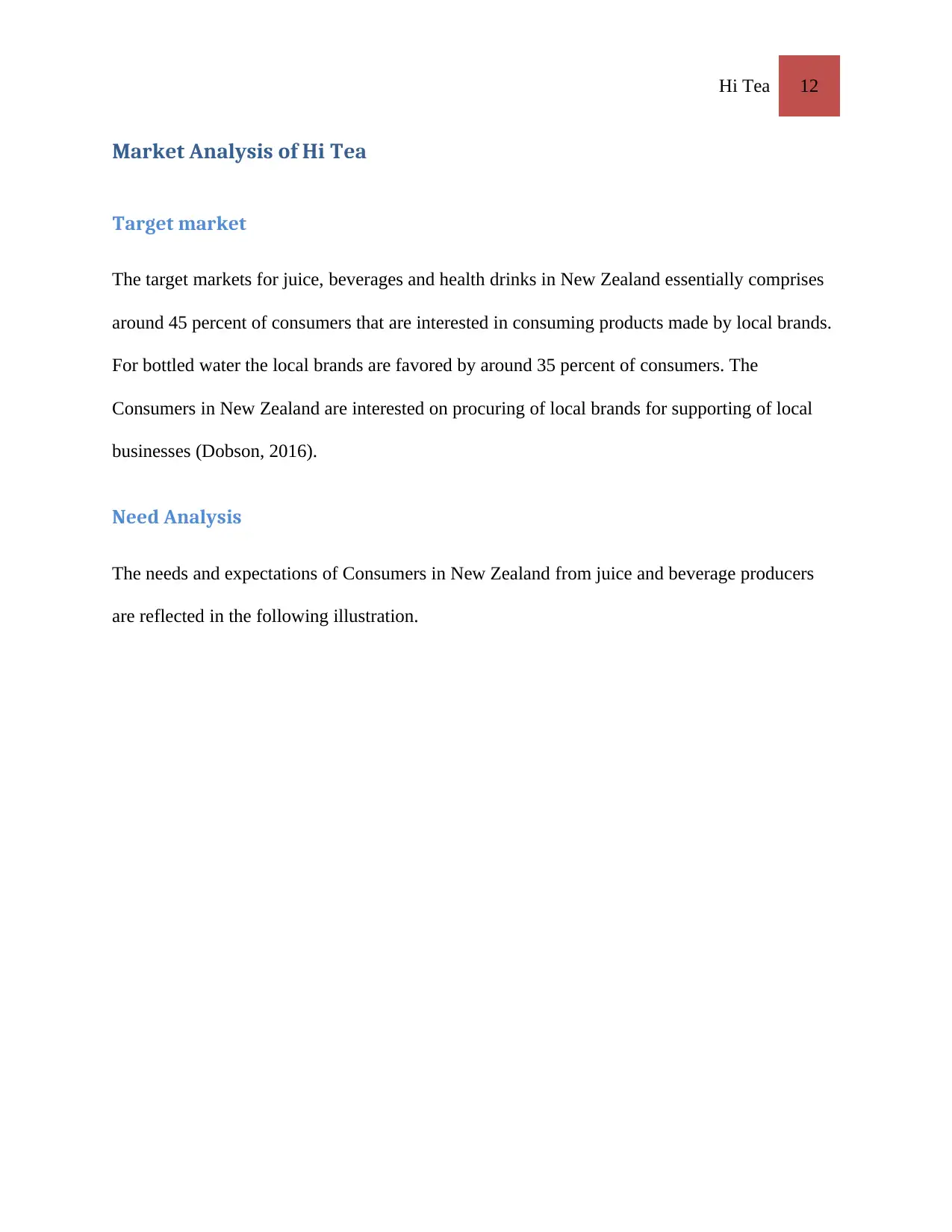
Hi Tea 12
Market Analysis of Hi Tea
Target market
The target markets for juice, beverages and health drinks in New Zealand essentially comprises
around 45 percent of consumers that are interested in consuming products made by local brands.
For bottled water the local brands are favored by around 35 percent of consumers. The
Consumers in New Zealand are interested on procuring of local brands for supporting of local
businesses (Dobson, 2016).
Need Analysis
The needs and expectations of Consumers in New Zealand from juice and beverage producers
are reflected in the following illustration.
Market Analysis of Hi Tea
Target market
The target markets for juice, beverages and health drinks in New Zealand essentially comprises
around 45 percent of consumers that are interested in consuming products made by local brands.
For bottled water the local brands are favored by around 35 percent of consumers. The
Consumers in New Zealand are interested on procuring of local brands for supporting of local
businesses (Dobson, 2016).
Need Analysis
The needs and expectations of Consumers in New Zealand from juice and beverage producers
are reflected in the following illustration.
⊘ This is a preview!⊘
Do you want full access?
Subscribe today to unlock all pages.

Trusted by 1+ million students worldwide
1 out of 24
Related Documents
Your All-in-One AI-Powered Toolkit for Academic Success.
+13062052269
info@desklib.com
Available 24*7 on WhatsApp / Email
![[object Object]](/_next/static/media/star-bottom.7253800d.svg)
Unlock your academic potential
Copyright © 2020–2025 A2Z Services. All Rights Reserved. Developed and managed by ZUCOL.





